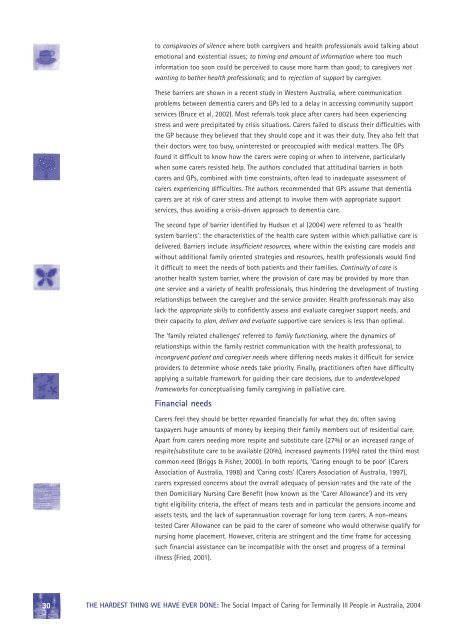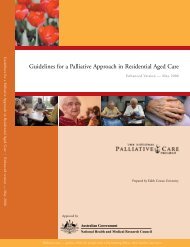The hardest thing we have ever done - Palliative Care Australia
The hardest thing we have ever done - Palliative Care Australia
The hardest thing we have ever done - Palliative Care Australia
Create successful ePaper yourself
Turn your PDF publications into a flip-book with our unique Google optimized e-Paper software.
to conspiracies of silence where both caregivers and health professionals avoid talking about<br />
emotional and existential issues; to timing and amount of information where too much<br />
information too soon could be perceived to cause more harm than good; to caregivers not<br />
wanting to bother health professionals; and to rejection of support by caregiver.<br />
<strong>The</strong>se barriers are shown in a recent study in Western <strong>Australia</strong>, where communication<br />
problems bet<strong>we</strong>en dementia carers and GPs led to a delay in accessing community support<br />
services (Bruce et al, 2002). Most referrals took place after carers had been experiencing<br />
stress and <strong>we</strong>re precipitated by crisis situations. <strong>Care</strong>rs failed to discuss their difficulties with<br />
the GP because they believed that they should cope and it was their duty. <strong>The</strong>y also felt that<br />
their doctors <strong>we</strong>re too busy, uninterested or preoccupied with medical matters. <strong>The</strong> GPs<br />
found it difficult to know how the carers <strong>we</strong>re coping or when to intervene, particularly<br />
when some carers resisted help. <strong>The</strong> authors concluded that attitudinal barriers in both<br />
carers and GPs, combined with time constraints, often lead to inadequate assessment of<br />
carers experiencing difficulties. <strong>The</strong> authors recommended that GPs assume that dementia<br />
carers are at risk of carer stress and attempt to involve them with appropriate support<br />
services, thus avoiding a crisis-driven approach to dementia care.<br />
<strong>The</strong> second type of barrier identified by Hudson et al (2004) <strong>we</strong>re referred to as ‘health<br />
system barriers’: the characteristics of the health care system within which palliative care is<br />
delivered. Barriers include insufficient resources, where within the existing care models and<br />
without additional family oriented strategies and resources, health professionals would find<br />
it difficult to meet the needs of both patients and their families. Continuity of care is<br />
another health system barrier, where the provision of care may be provided by more than<br />
one service and a variety of health professionals, thus hindering the development of trusting<br />
relationships bet<strong>we</strong>en the caregiver and the service provider. Health professionals may also<br />
lack the appropriate skills to confidently assess and evaluate caregiver support needs, and<br />
their capacity to plan, deliver and evaluate supportive care services is less than optimal.<br />
<strong>The</strong> ‘family related challenges’ referred to family functioning, where the dynamics of<br />
relationships within the family restrict communication with the health professional, to<br />
incongruent patient and caregiver needs where differing needs makes it difficult for service<br />
providers to determine whose needs take priority. Finally, practitioners often <strong>have</strong> difficulty<br />
applying a suitable framework for guiding their care decisions, due to underdeveloped<br />
frameworks for conceptualising family caregiving in palliative care.<br />
Financial needs<br />
<strong>Care</strong>rs feel they should be better rewarded financially for what they do, often saving<br />
taxpayers huge amounts of money by keeping their family members out of residential care.<br />
Apart from carers needing more respite and substitute care (27%) or an increased range of<br />
respite/substitute care to be available (20%), increased payments (19%) rated the third most<br />
common need (Briggs & Fisher, 2000). In both reports, ‘Caring enough to be poor’ (<strong>Care</strong>rs<br />
Association of <strong>Australia</strong>, 1998) and ‘Caring costs’ (<strong>Care</strong>rs Association of <strong>Australia</strong>, 1997),<br />
carers expressed concerns about the overall adequacy of pension rates and the rate of the<br />
then Domiciliary Nursing <strong>Care</strong> Benefit (now known as the ‘<strong>Care</strong>r Allowance’) and its very<br />
tight eligibility criteria, the effect of means tests and in particular the pensions income and<br />
assets tests, and the lack of superannuation coverage for long term carers. A non-means<br />
tested <strong>Care</strong>r Allowance can be paid to the carer of someone who would otherwise qualify for<br />
nursing home placement. Ho<strong>we</strong>ver, criteria are stringent and the time frame for accessing<br />
such financial assistance can be incompatible with the onset and progress of a terminal<br />
illness (Fried, 2001).<br />
30 THE HARDEST THING WE HAVE EVER DONE: <strong>The</strong> Social Impact of Caring for Terminally Ill People in <strong>Australia</strong>, 2004
















